Camouflage isn’t always all it’s kicked up to be.
Just when you think it’s safe, along comes a mockingbird and plucks a large green something out of the grass, flies off with it and lands not quite close enough to capture with a phone camera. This particular quarry was bright green — the color of grass — it should have been safe, right? Except to the eagle eye of a mockingbird, apparently.
The prize was about two inches long and a half inch in diameter. In the bird realm, it might have been heavy. The mockingbird placed it on the ground and plucked at it a half dozen times before picking up the remains in its beak and flying into the bushes, undoubtedly to feed a nest full of chicks. Sad for the caterpillar, but the chicks must be fed, I can’t fault that.
A more successful tale of camouflage is with a western giant swallowtail caterpillar that had been feeding in a colima tree for a while. Still in its bird-dropping pattern — a most clever concealment in itself, although it blends better with the grayness of colima bark than it had on the green leaves.
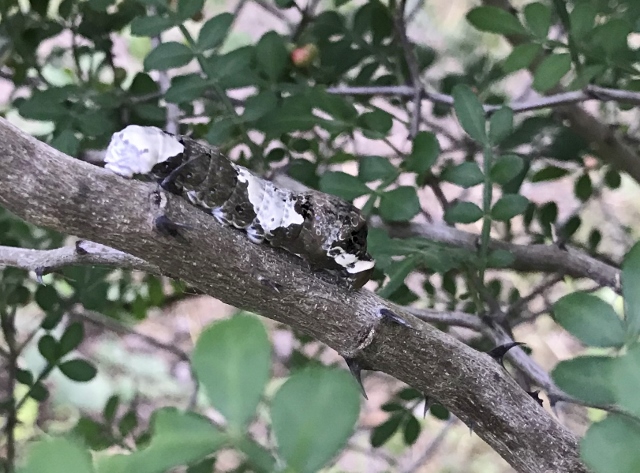
I finally traced a giant swallowtail caterpillar ready to make the change. It had left the colima tree and attached itself to a dead vine that had intertwined with the chain-link fence where colima branches have pushed through.
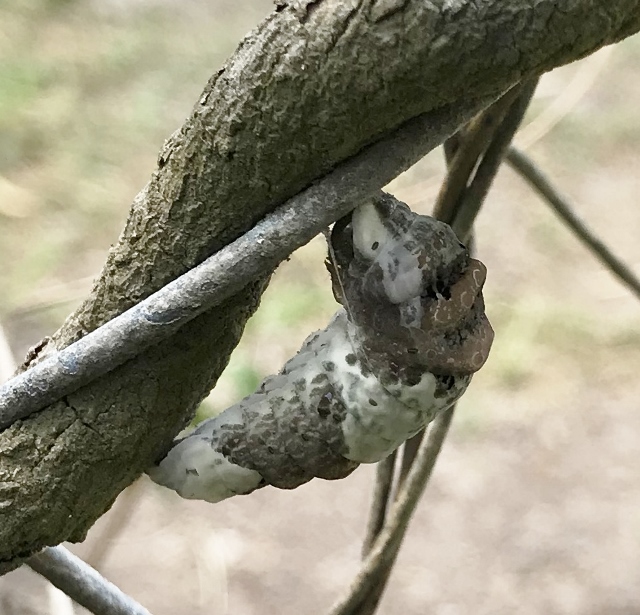
Many butterfly caterpillars attach one end to a structure, hang upside down in a J shape before spinning a chrysalis. Some, like this giant swallowtail, seem to need a bit more stability, and secrete a fluid that makes strong life-line-like filaments.
I make my rounds in the early mornings when there seems to be more caterpillar activity. I wasn’t to visit this giant swallowtail site until the next morning; I hoped nothing would interrupt it before it had spun its chrysalis. Fortunately, the chrysalis was complete the next morning. During the process, it had released its front end from the vine and was suspended by the tail attachment and two filaments. The end result is a good imitation of a piece of bark dangling from a vine — a natural happening amongst trees, and an appropriate façade for this developing butterfly.

Colima (Zanthoxylum fagara) is one of my favorite native trees; although until recently, I hadn’t realized it was so entertaining. Recall, colima is where I first found the beautiful Lebeau’s silk moth last month. https://rgvctmn.org/anitas-blog-startling-garden-finds/
If you’re looking to add a smallish, neatly compact tree to your garden, consider colima. It’s a pretty tree with a shade lighter and brighter green than most trees, and it keeps its leaves all year. The bark ages in various shades of gray.
Colima is unique in that it’s the only native tree that has a viaduct- or trough-like rachis — rachis being the main stem of a compound leaf.
It’s not a particularly friendly tree — quite the opposite — it’s kinda snarly, tending to lash out and pierce one’s skin with multiple needle-sharp cat-claw-like recurved prickles; it clutches at clothing as if with a dozen fishing hooks at once and doesn’t let go easily.

Despite its surly ways, I like it. It’s always ready to defend its surroundings, if you’re in need of an inexpensive security fence. My colima trees are currently laden with tiny green berries just beginning to turn red and black. Great bird food once the berries are ripe.
Besides entertaining a goodly number of giant swallowtail caterpillars, the colimas have hosted several gulf fritillary caterpillars, too — oh, not like you’re thinking. There’s a recurring passion vine (Passiflora foetida) creeping up the chain-link fence at the end of the colima row. After the gulf fritillary caterpillars get their fill on their host passion vine, they travel along the colima branches, find a spot, hook on, hang in a J and then spin their chrysalis. The gulf fritillary chrysalis looks like a dead leaf — now there’s a clever bit of camouflage. The fritillaries also find the chain-link fence and its dead vines handy for their transformation phase.
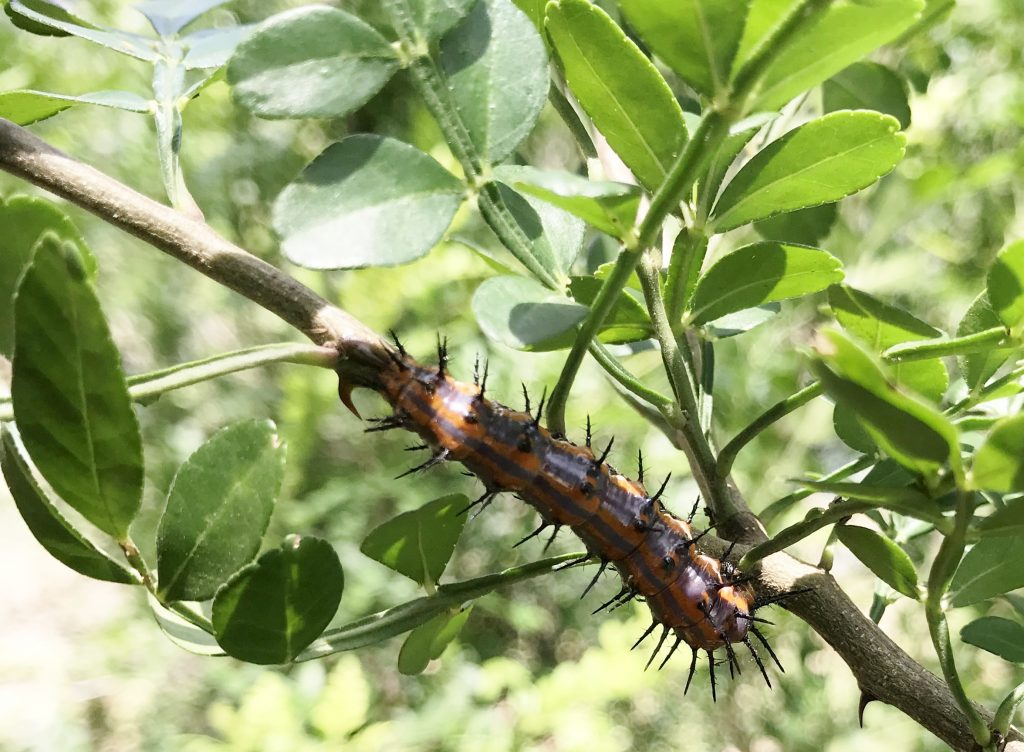
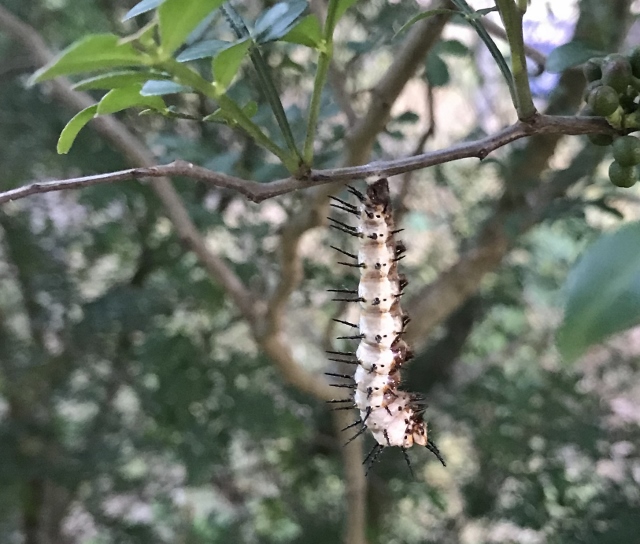
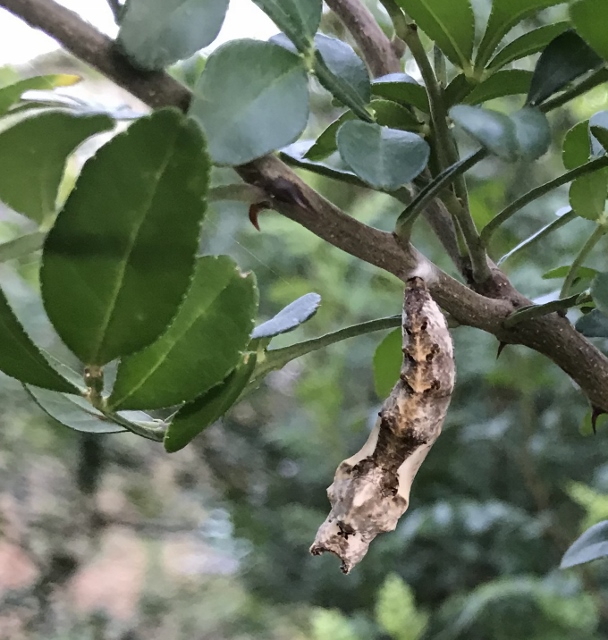
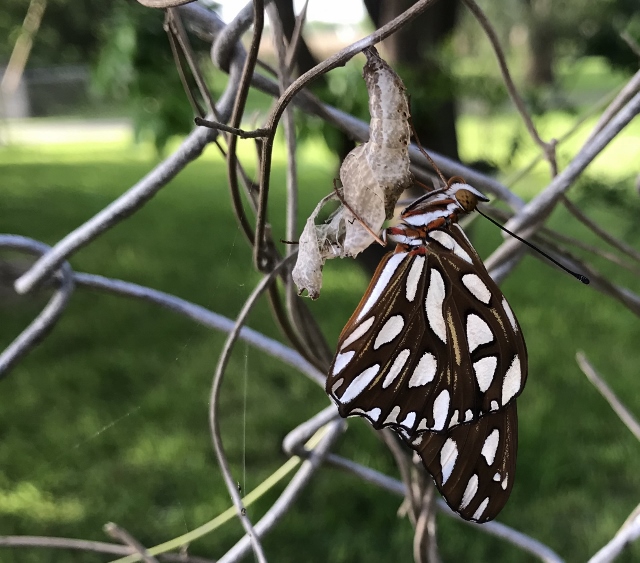
Butterflies aside, it’s National Moth Week soon! July 18 – 26.
This is a Citizen Scientist activity that would count for Texas Master Naturalist volunteer hours. Photos of moths and bugs from a moth-ing event uploaded to iNaturalist.org also is a countable volunteer Citizen Scientist activity.
I’ve been experimenting with various set-ups in different areas of the yard to see if I might attract more variety of species.
I was interested to know that the mothing world has a bird-drop — not as a caterpillar disguise like the giant swallowtail, but used in the name. In the Tarache genus of moths, those found nearby include these names:
- exposed bird dropping moth,
- four-patched bird-dropping moth
- olive-shaded bird-dropping moth
Chalky bird dropping moth and small bird-dropping moth are not annotated in iNaturalist.org as being close by, but also are listed as visually similar. I can’t distinguish all the nuances between the five choices, so I’ll leave it to the iNaturalist.org experts
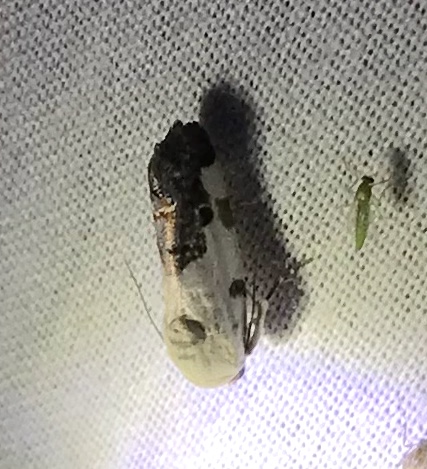
Two other new-to-me moths that visited my mothing sheet this week were an eight-barred lygropia moth and a one-banded lichen moth
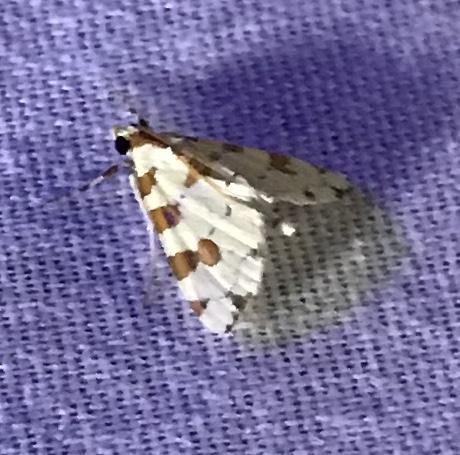
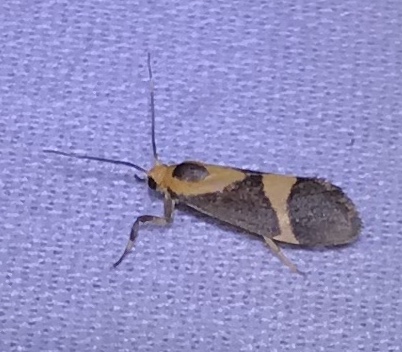
Mothing is becoming a great national pastime for those who want to search out the mysteries of the dark — nighttime that is! If you haven’t seen the latest Rio Grande Valley Chapter, Texas Master Naturalist newsletter, check out the “Moth-ing” story at the below link for a quick moth sheet set up:
https://rgvctmn.org/wp-content/uploads/2020/07/Chachalaca_0620.pdf
Toward the end of the article is a link to Joseph Connors’ more extensive blog post about mothing. Joseph is South Texas Border Chapter of the Texas Master Naturalist’s Webmaster, Creatures of the Night co-presenter and avid moth-er. He has prepared a more in depth account about moth-ing on the South Texas Border Chapter’s website at the following link: https://www.stbctmn.org/post/mothing